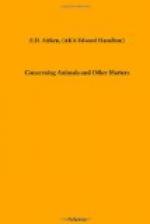is furnished on both sides with a loose fringe which
we will call the first strainer. The upper jaw
is thin and flat and rests on the lower like a lid,
and it is beautifully fringed along both sides with
small, leathery points, close set, like the teeth
of a very fine saw. This is the second strainer.
To work the machine you dip the point into dirty water
full of water-fleas, draw back the tip of the tongue
a little, and suck in water till the lower jaw (the
pipe) is full, then close the point again with the
tip of the tongue and force the water out. It
can only get out by passing through the first strainers
at the root of the tongue, then over the palate, and
so through the second strainers at the sides of the
bill; and all the solid matter it contained will remain
in the mouth. The sucking in and squirting out
of the water is managed by the cheeks, or rather by
the cheek, for a flamingo has only one cheek, and that
is situated under the chin. When the bird is
feeding you will see this throbbing faster than the
eye can follow it, while water squirts from the sides
of the mouth in a continuous stream. I should
have said that the whole bill is sharply bent downwards
at the middle. The advantage of this is that
when the bird lets down its head into the water, like
a bucket into a well, the point of the bill does not
stick in the mud, but lies flat on it, upside down.
In conclusion, let us not fail to note, whatever be
our political creed, that, while all the birds pursue
their respective industries, there sit apart, in pride
of place, some whose bills are not tools wherewith
to work, but weapons wherewith to slay. And these
take tribute of the rest, not with their consent,
but of right.
III
TAILS
The secrets of Nature often play like an iridescence
on the surface, and escape the eye of her worshipper
because it is stopped with a microscope. There
are mysteries all about us as omnipresent as the movement
of the air that lifts the smoke and stirs the leaves,
which I cannot find that any philosopher has looked
into. Often and deeply have I been impressed
with this. For example, there is scarcely, in
this world, a commoner or a humbler thing than a tail,
yet how multifarious is it in aspect, in construction,
and in function, a hundred different things and yet
one. Some are of feathers and some of hair, and
some bare and skinny; some are long and some are short,
some stick up and some hang down, some wag for ever
and some are still; the uses that they serve cannot
be numbered, but one name covers them all. In
the course of evolution they came in with the fishes
and went out with man. What was their purpose
and mission? What place have they filled in the
scheme of things? In short, what is the true
inwardness of a tail?




